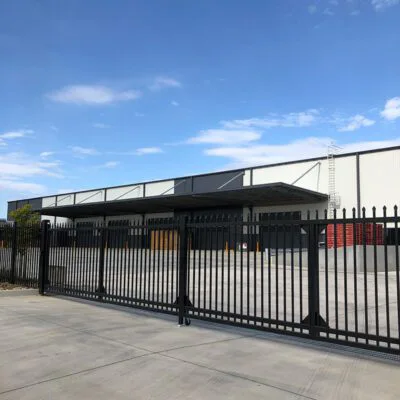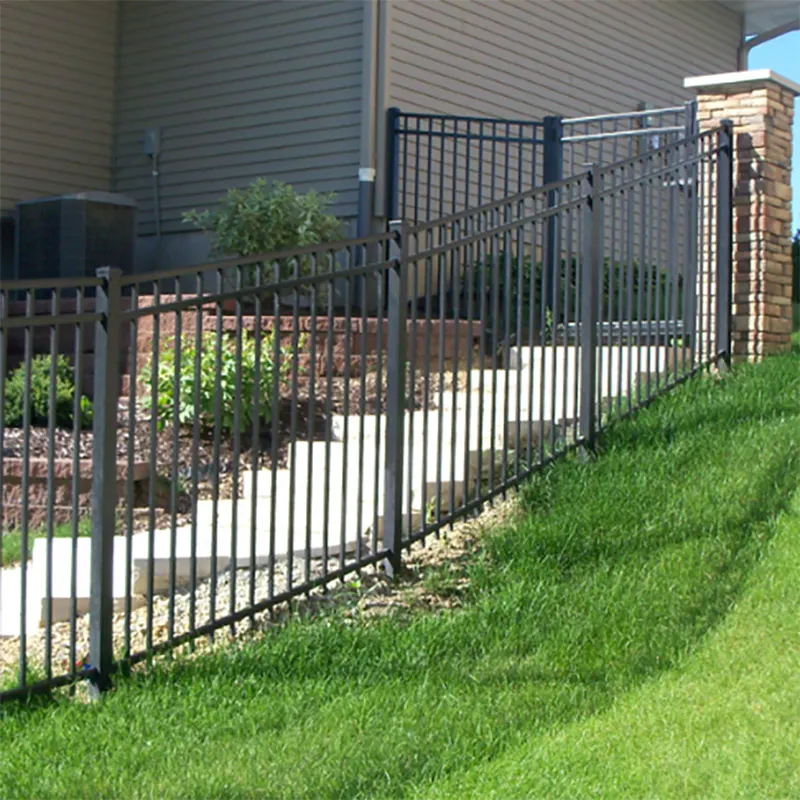
The flat-bottom 2-rail fence is a popular choice for both residential and commercial applications due to its sleek design, durability, and ease of installation. The product is very similar to our Flat Top Metal Ornamental Iron Fence Panel; however, they differ in details. This type of fence not only enhances the aesthetic appeal of any property but also provides reliable security. As a professional manufacturer, we take pride in our comprehensive flat-bottom 2-rail fence production process, which ensures the highest standards of quality. From the precise extrusion of aluminum profiles to the final packaging, each step is meticulously designed to deliver a product that meets both functional and decorative needs. In this blog, we will explore the detailed 8-step production process, discuss the installation methods, and highlight the key advantages of our flat-bottom 2-rail fence.

Our flat-bottomed, double-rail fencing production begins with profile extrusion, a key technology that uses mechanical stress to shape aluminum into the desired form. We heat high-quality aluminum ingots to a precise temperature (typically between 480-520°C) to achieve optimal forgeability. Then, under pressure, the ingots pass through specialized extrusion dies, precisely shaping them into the various profiles required for our fencing designs.
Highlight: Our extrusion dies are highly precise, ensuring highly consistent profile dimensions and perfectly reproducible designs. This process not only ensures overall product consistency but also enables customized designs tailored to specific customer needs, delivering up to 95% material utilization and significantly reducing waste.
Once the extrusion profiles have cooled, the next step is cutting the material. We use advanced CNC laser cutting technology to cut profiles into the precise length required for assembly, and the cutting accuracy tolerance is controlled within 0.5mm. Accurate cutting is critical as it ensures that the fence sections fit together seamlessly, maintaining the structural integrity of the flat-bottom 2-rail fence. Precision is key at this stage since incorrect cuts can lead to poor alignment during assembly, affecting the final product’s strength and appearance.
Rail punching involves creating holes in the horizontal beams where vertical slats or pickets will later be inserted. This step is particularly important for the flat-bottom 2-rail fence as it ensures that all parts can be assembled securely. Using CNC machines, we achieve high precision in hole placement, preventing any misalignment during the final assembly process. Our punching process can flexibly customize the spacing between columns according to customers’ specific requirements for design and safety.
With the materials cut and punched, the assembly of fence panels begins. Horizontal rails are attached to the vertical posts and pickets, creating the ornamental fence panel structure. We can provide 2-rail or 3-rail configuration options according to the customer’s requirements. Correct assembly requires extreme attention to detail. We use high-strength stainless steel fasteners or robotic welding technology to ensure that each connection point can withstand a tensile test of up to 500 kg. The assembly efficiency of this link is increased by 30% compared to traditional methods. The flat-bottom 2-rail fence production process allows for a sleek, modern look, and this assembly stage is critical in ensuring the fence’s aesthetic appeal and strength.
Before the final coating, we perform a crucial chrome-free passivation treatment on the fence surface. This process uses an environmentally friendly chemical method to form a dense conversion coating on the aluminum surface, typically 3-5 microns thick.
Highlights: This conversion coating significantly improves the adhesion of the subsequent powder coating, increasing the bond strength by up to 2-3 times. It also significantly enhances the aluminum’s corrosion resistance, extending the fence’s service life by up to 20% in harsh environments. The chrome-free passivation process meets the world’s most stringent environmental standards and is a key component of sustainable production.
One of the most critical steps in producing a flat-bottom 2-rail fence is the powder coating process. We use advanced electrostatic powder spraying technology, and the spraying thickness is strictly controlled between 80-120μm to ensure uniform and defect-free coating. This high-quality epoxy polyester powder coating not only provides a smooth and uniform visual surface, but also passes 1000 hours of salt spray test and has excellent UV resistance. Powder coating is preferable to traditional painting methods because it results in a more durable, attractive finish while being more environmentally responsible due to reduced emissions of volatile organic compounds (VOCs).
After the powder coating process, we conduct a rigorous quality inspection. Our technicians check for any defects, ensuring that all components meet the necessary safety and durability standards. The inspection includes visual checks for coating uniformity, thickness measurement, and structural integrity tests. Quality control is crucial to maintaining our reputation as a professional flat-bottom 2-rail fence manufacturer. This comprehensive inspection guarantees that the final product will perform as expected in a variety of conditions, offering reliability and longevity.
The final step in the flat-bottom 2-rail fence production process is packaging. We use robust packaging methods to protect the fences during transportation. We use iron pallets + wrapping film + four-corner cardboard protection + packing tape to pack the products. It ensures the safety of the products and avoids bumps and scratches. Each component is carefully wrapped and secured to prevent scratches, dents, or other damage. Additionally, we offer custom packaging solutions for international shipments, ensuring that the product arrives at the client’s location in perfect condition.
Our design prioritizes ease of installation while ensuring long-term stability and durability. The following points explain the connection methods used during installation:
Horizontal Rails to Posts Connection
The horizontal rails are connected to the vertical posts using self-tapping screws. This method provides a secure and reliable attachment, ensuring that the rails remain firmly in place under various weather conditions. The use of self-tapping screws simplifies the installation process, allowing for quick assembly without the need for specialized tools or welding.
Vertical Tubes to Horizontal Rails Connection
The vertical pickets (or tubes) are inserted through pre-punched holes in the horizontal rails. Once positioned, they are securely fastened using self-tapping screws. This method not only ensures a tight fit but also enhances the overall structural integrity of the fence. The vertical pickets are aligned precisely to maintain uniform spacing, contributing to both the fence’s aesthetic appeal and security features.
Our flat-bottom 2-rail fence stands out due to several key advantages, making it an ideal choice for both residential and commercial applications. These advantages include:
Crafted from high-quality aluminum, our fences boast outstanding resistance to corrosion, weathering, and impact. The advanced pre-treatment and powder coating processes significantly enhance their durability, ensuring a long-lasting product that requires minimal upkeep.
Our fences are designed for effortless assembly using self-tapping screws, eliminating the need for welding or specialized tools. This user-friendly approach allows for quick installation while preserving the structural integrity of the fence, making it suitable for both DIY enthusiasts and professional installers.
We provide a wide array of customization options for our flat-bottom 2-rail fences, enabling customers to select from various dimensions, finishes, and configurations. Whether you require specific spacing between vertical pickets, different rail sizes, or a unique powder coating color, our production process can accommodate your design preferences.
The sleek design of the flat-bottom 2-rail fence offers a modern and sophisticated look that complements diverse architectural styles. Its smooth, powder-coated finish and clean lines enhance its aesthetic charm, making it a favored choice for ornamental applications.
We are committed to sustainability, employing environmentally friendly production methods such as chromium-free passivation and powder coating. These techniques minimize harmful emissions and waste, making our fences an eco-conscious choice without sacrificing quality or performance.
Our fences are engineered not only for beauty but also for security. The robust connection between rails and pickets, combined with durable materials, creates a formidable barrier that ensures effective protection for both residential and commercial properties.
The production of a flat-bottom 2-rail fence involves a highly specialized and detailed process. Each step plays a crucial role in ensuring the fence’s durability, structural integrity, and aesthetic appeal. It’s also essential to consider the ease of installation and the numerous advantages this fence design offers. With its high durability and customizable options, our flat-bottom 2-rail fence stands out as a superior choice in the fencing industry.